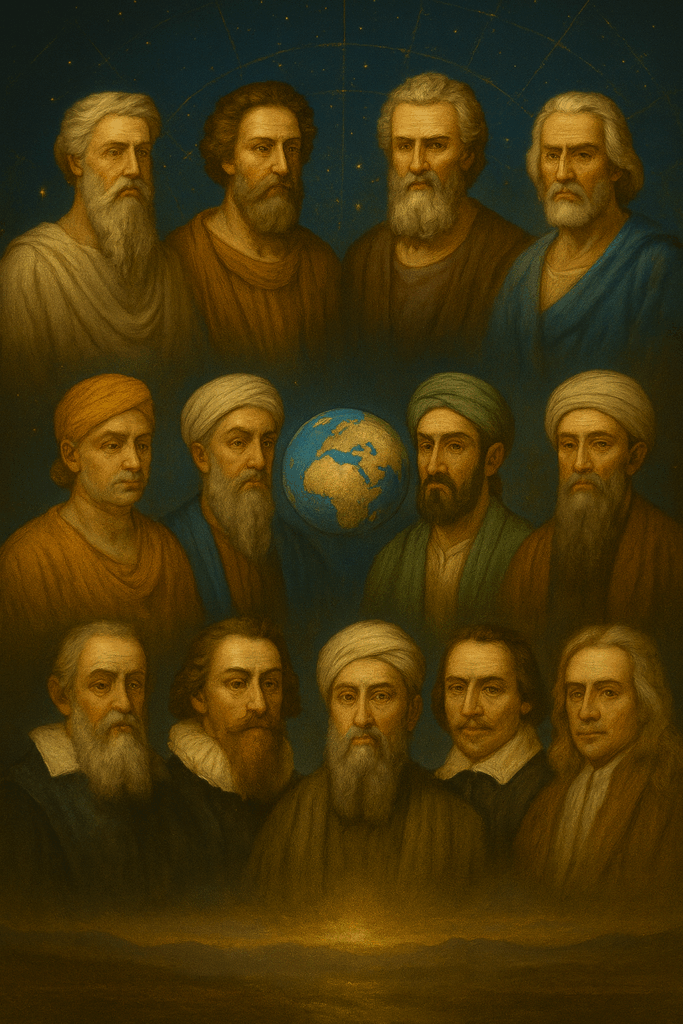Since ancient times, the question of the Earth’s position in the universe has been a subject of debate among philosophers and scientists. Is the Earth fixed at the center of the cosmos, or does it rotate on its axis and orbit the Sun? This idea did not emerge suddenly, but rather evolved through a long intellectual journey – from Greek philosophy, through India and the Islamic world, to modern Europe. Below is an overview of the most important scholars who contributed to establishing the idea of Earth’s rotation:
- Pythagoras (570–495 BC) – Greece 🇬🇷
He pointed out that the Earth is spherical and connected this to cosmic harmony. His ideas were more philosophical, but they paved the way for scientific thinking about the Earth’s motion. - Philolaus (470–385 BC) – Greece 🇬🇷
A follower of the Pythagorean school who stated that the Earth is not stationary but revolves around a “central fire,” an early conception of cosmic movement. - Heraclides Ponticus (390–310 BC) – Greece 🇬🇷
Among the first to propose that the Earth rotates daily on its axis, explaining the alternation of day and night. - Aristarchus of Samos (310–230 BC) – Greece 🇬🇷
He presented the first clear heliocentric model, claiming that the Earth rotates on its axis and orbits the Sun, though his ideas were not accepted at the time. - Aryabhata (476–550 AD) – India 🇮🇳
A prominent mathematician and astronomer who stated that the Earth’s rotation is the true cause of day and night, and provided precise mathematical equations. - Al-Biruni (973–1050 AD) – Khwarazm/Uzbekistan 🇺🇿
He extensively discussed the possibility of Earth’s rotation, examining it with mathematical and astronomical evidence. For him, it was a scientific hypothesis worthy of serious consideration. - Avicenna (980–1037 AD) – Bukhara/Uzbekistan 🇺🇿
In his philosophical and scientific works, he considered the possibility of Earth’s motion, balancing observational arguments with theoretical reasoning, without making a final judgment. - Nasir al-Din al-Tusi (1201–1274 AD) – Iran 🇮🇷
Developed an advanced mathematical model of planetary motion, known as the “Tusi Couple,” which later had a great influence on European astronomy. - Nicolaus Copernicus (1473–1543) – Poland 🇵🇱
Revived the heliocentric model and mathematically proved that the Earth rotates on its axis and around the Sun, igniting the scientific revolution. - Galileo Galilei (1564–1642) – Italy 🇮🇹
Using the telescope, he discovered Jupiter’s moons and the phases of Venus. His observations provided strong evidence that the Earth is not the center of the universe. - Johannes Kepler (1571–1630) – Germany 🇩🇪
Formulated the three laws of planetary motion, confirming that the Earth moves in an elliptical orbit around the Sun, strengthening the heliocentric model. - Isaac Newton (1642–1727) – England 🇬🇧
With the law of gravitation and the laws of motion, he provided the final physical and mathematical explanation of Earth’s rotation and planetary motion, uniting the Earth and the heavens under one natural law.
The idea of Earth’s rotation was not the work of a single scholar but the result of contributions from many minds across centuries. It began with philosophical speculation in ancient Greece, advanced with mathematical precision in India and the Islamic world, and reached its peak in Europe with Copernicus, Galileo, and Kepler. Finally, Newton gave it its decisive scientific foundation. Thus, what once was a controversial hypothesis became a fundamental scientific fact for understanding the universe.

